Learn how common household products made women sick.
At home, we are surrounded by products we use daily without a second thought.
From personal care products to cleaning products, these household products have become essential to our routines.

But, some everyday products may harbor a hidden danger, especially to women’s health.
Women tend to use more personal care on average than men and they may be exposed more to some household chemicals because of traditional gender roles regarding household maintenance.
More exposure means women will face a higher risk for potential health concerns tied to these products as microbes in household products as well as environmental health risks of house.
It is important to know these risks and make educated decisions on the products we bring into our homes to safeguard ourselves and the health of our families.
Household Products List
I. The Hidden Dangers in Your Bathroom
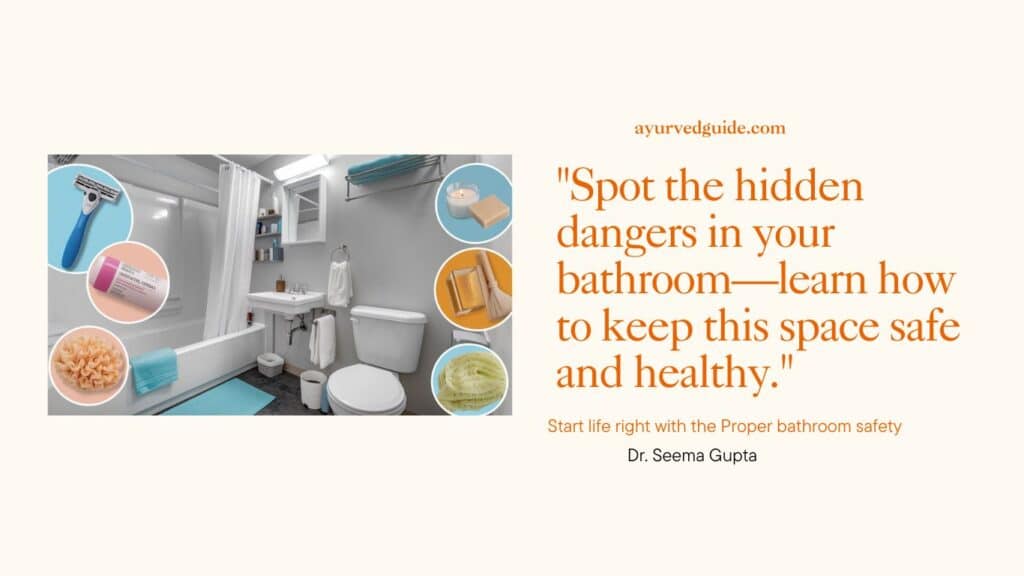
Your bathroom is more than just a needy space; it’s where you start and end your day.
However, the warm, humid environment of the bathroom can turn some seemingly harmless items into health hazards.
Here are five things you should never keep in the bathroom: Hidden Dangers in Bathrooms
1. Old Razors – Household Products
Old razors are the breeding ground for bacteria. As they sit in the moist environment of your bathroom, rust can develop, and the blades become dull, increasing the risk of cuts and infections.
Replace your razor blades regularly or switch to a high-quality electric razor to avoid this issue.
2. Harsh Antibacterial Soaps – Hidden Dangers in Bathrooms
While harsh antibacterial soaps may feel like the best defense against germs, they can actually be bad for your skin health.
These soaps often contain powerful chemicals that strip away the natural oils protecting your skin and disrupt the natural balance of bacteria.
This may cause dryness, irritation, and even conditions like eczema. Instead of harsh antibacterial soaps, use soaps made with ingredients like aloe vera, coconut oil, and essential oils.
These support the balance of your skin, helping you maintain healthy, hydrated skin without the risk of irritation and dryness.
Read also, 10 Reasons for Faint Line on Pregnancy Test
3. Scented Candles – Household Products
While scented candles can create a relaxing atmosphere, keeping them in the bathroom might not be the best idea. The moisture in the air can affect the quality of the candle, causing it to lose its fragrance over time.
Additionally, some scented candles contain harmful chemicals that can be released into the air when burned, especially in a small, enclosed space like a bathroom.
Opt for natural alternatives like essential oil diffusers, which are safer and more effective in maintaining a pleasant aroma.
4. Old or Unused Makeup – Hidden Dangers in Bathrooms
Makeup can harbor bacteria, especially when kept in a damp environment like the bathroom especially when bathroom ventilation is not proper. Old or unused products can cause skin irritation, breakouts, and even eye infections.
Regularly declutter your old makeup and ensure that all products are stored in a cool and dry place to prolong their shelf life.
5. Damp Towels and Loofahs – Household Products
Towels and loofahs are prime environments for mold and bacteria. When left damp in the bathroom, they don’t always dry completely, especially in poorly ventilated spaces.
After use, make sure to hang them outside the bathroom in a well-ventilated area or wash them frequently in hot water to keep them fresh and hygienic.
Remember, your bathroom should be a retreat—a place where you can focus on self-care and relaxation so bathroom ventilation should be proper.
By removing these five items, you can ensure that this space remains safe and healthy, allowing you to fully enjoy the peace it’s meant to offer.
The bathroom is a place for relaxation and peace. When these harmful items are removed, you will definitely have that peaceful and relaxing time that the bathroom is meant to provide.
II. Personal Care Products
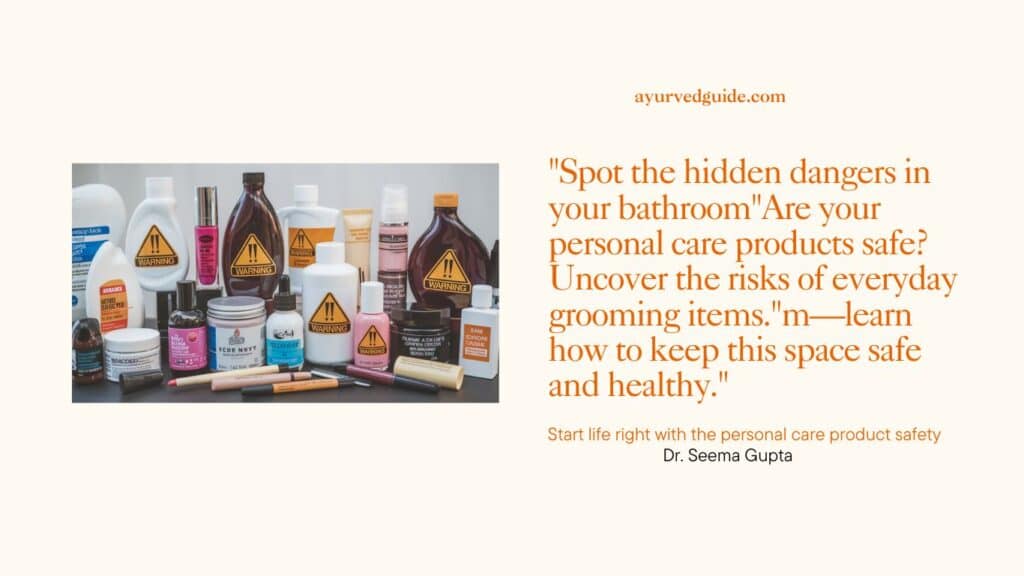
A. Hair dyes and relaxers – Personal Care Product Safety
Hair dyes and relaxers tend to also include aggressive chemicals that can irritate the scalp, and they can potentially be absorbed into the body through the skin.
B. Nail polish and removers – Household Products
Nail polish and gel nail products often contain chemicals such as formaldehyde, toluene, and dibutyl phthalate (DBP), which have been tied to respiratory problems and hormone disruption and may cause fertility impacts.
C. Cosmetics and Skin Care Products – Personal Care Product Safety
Many cosmetics and skincare products contain parabens, preservatives that can mimic the hormone estrogen in the body.
Although the long-term impact of low-level exposure is yet to be fully established, some scientists are concerned about possible associations with breast cancer and fertility impacts.
III. Cleaning Supplies – Household Products
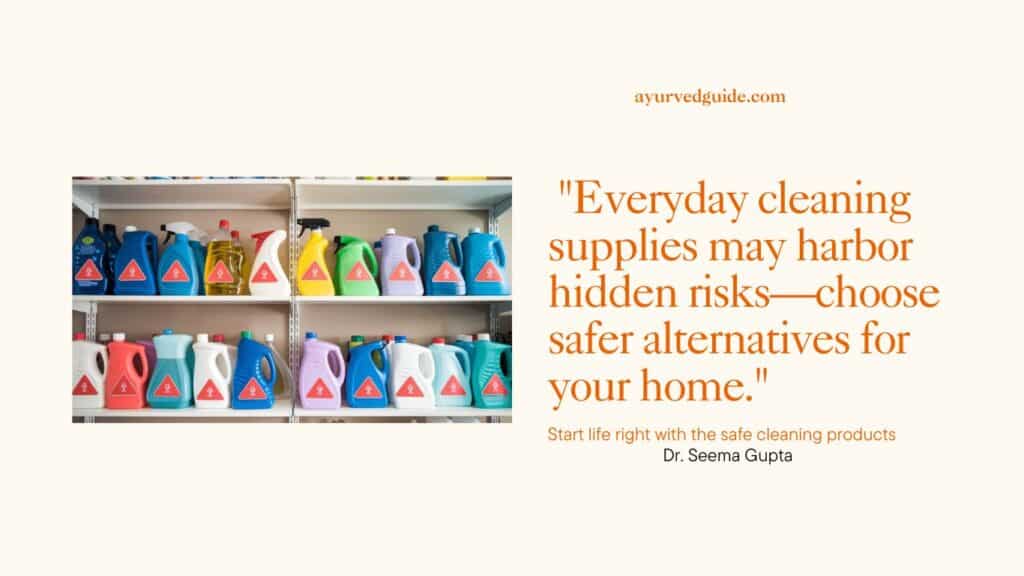
A. All-purpose cleaners
Many all-purpose cleaners contain volatile organic compounds (VOCs)! But regular use of cleaning products has been as damaging to lung function as smoking cigarettes, some studies have proposed.
B. Laundry soaps and fabric softeners
These Household Products often contain fragrances and other chemicals, which can lead to skin irritations and allergic reactions in those with sensitive skin.
Certain components of fabric softeners have been associated with respiratory problems and fertility impacts.
C. Air fresheners and Room Deodorizers – Household Products
Air fresheners can contain known endocrine disruptors, like phthalates. Regular exposure to such chemicals may impact reproductive health and fetal development during pregnancy.
IV. Food Packaging and Plastic Containers
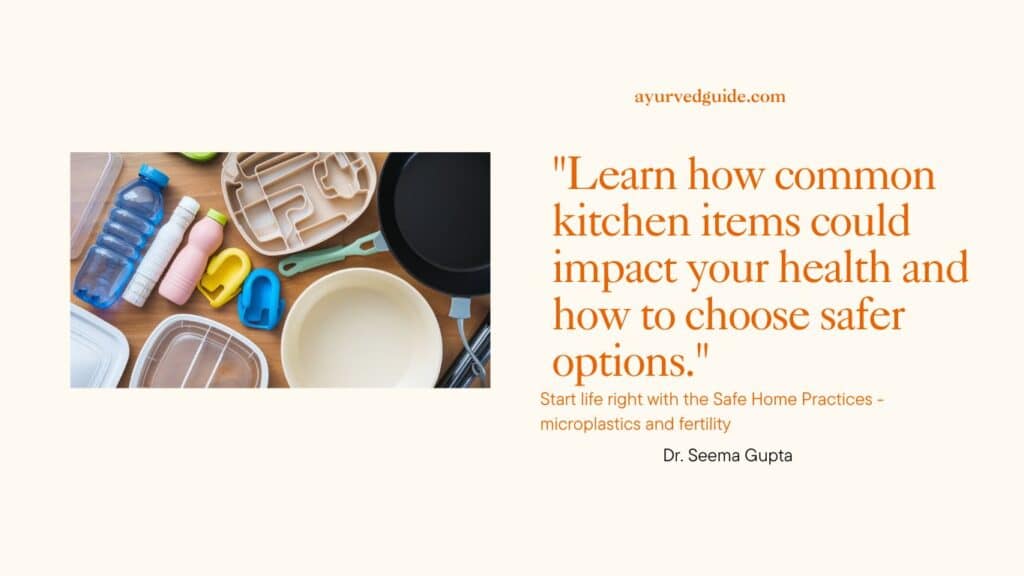
A. Plastic Water Bottles and Food Storage Containers
Plastic containers often include bisphenol A (BPA) or similar chemicals that may leach into food and beverages.
Microplastics and Fertility – These chemicals have been associated with hormonal disruptions and reproductive problems.
B. Non-stick cookware – Household Products
When heated, non-stick cookware can emit a chemical called perfluorooctanoic acid, or PFOA, which has been associated with thyroid disease, infertility, and some cancers.
C. Canned food linings
Certain canned food linings contain BPA and can leach into the food. Regular consumption of canned foods may increase exposure to BPA.
V. Feminine Hygiene Products
A. Tampons and pads – Personal Care Product Safety
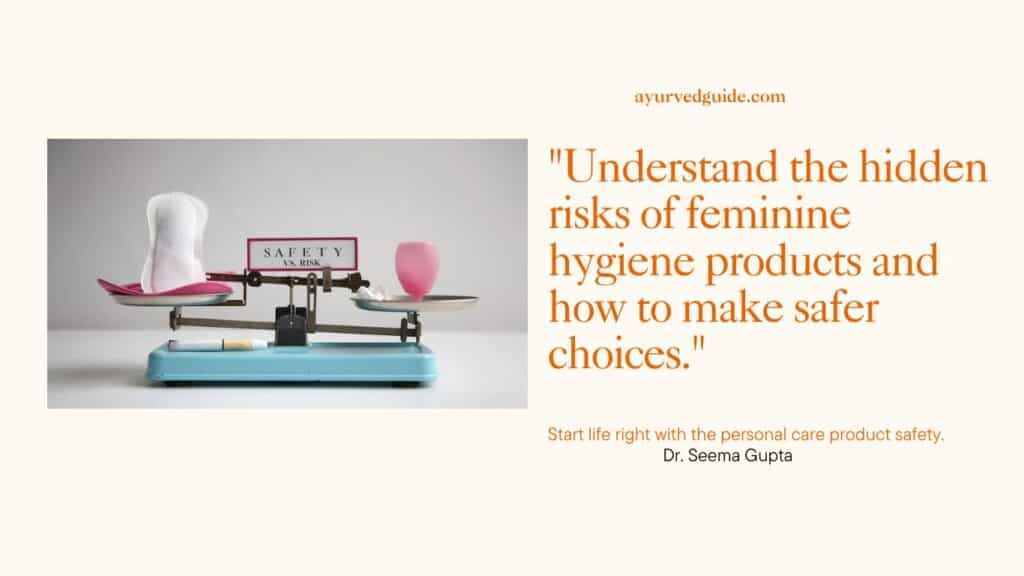
They may also contain traces of dioxins used in the bleaching process and toxins from pesticides used on non-biological cotton.
Though levels are usually deemed low.
B. Douches and intimate washes
Frequent usage of douches and intimate washes may interfere with the natural balance of bacteria in the vagina, which can cause infections.
Others can contain dangerous chemicals that seep into delicate tissues.
C. Menstrual cups and other alternatives – Personal Care Product Safety
Although generally seen as low-risk alternatives, certain Household Products like menstrual cups may be manufactured from materials that can potentially be of concern.
One should research the materials as well as the manufacturing processes for these products.
VI. Health and Wellness Items
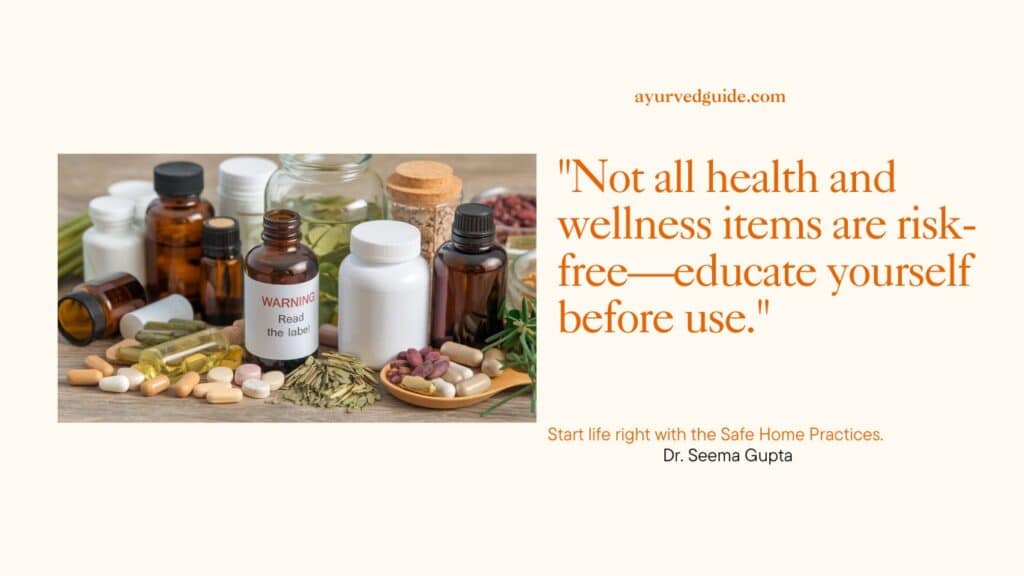
A. Dietary supplements
The supplement industry is largely unregulated, and some products may contain contaminants or undisclosed ingredients that might be harmful.
B. Herbal remedies
Herbal medicines aren’t all safe or effective, and some may interfere with medications or have unanticipated side effects.
That’s why it’s crucial to check with a doctor care before using herbal products.
C. Essential oils
Although many people use essential oils for their potential health benefits, they can sometimes irritate skin or trigger an allergic reaction. Some oils also can exert hormone-like effects inside the body.
Read more, How to Get Periods Immediately if Delayed – Treatment
VII. Potential Health Risks – Household Products
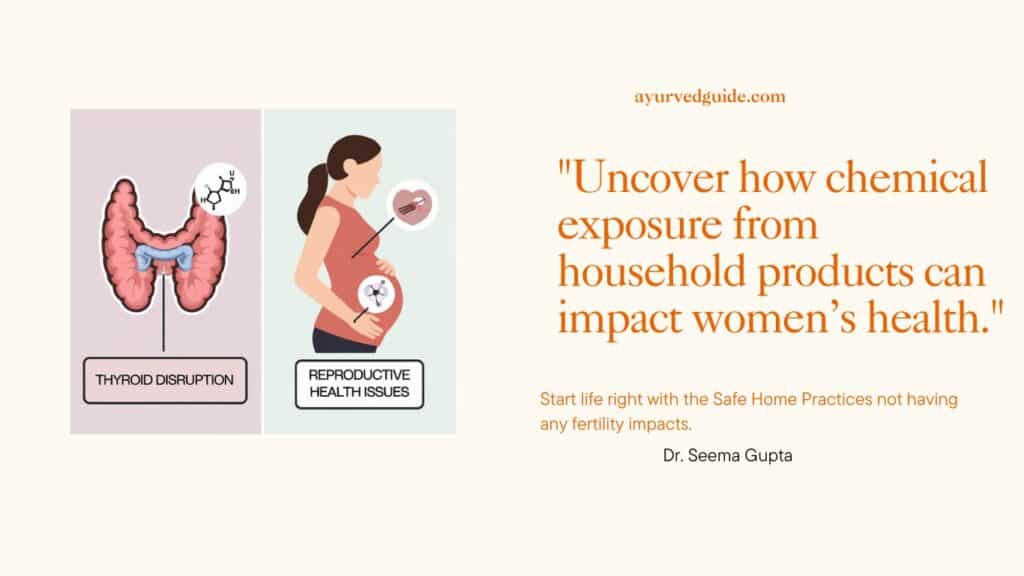
A. Hormonal disruption
Microplastics and Fertility – Plastic chemicals in common household products through the skin, interfere with the endocrine system, leading to thyroid problems, fertility problems, early onset of puberty, etc.
B. Reproductive issues – Household Products
Exposure to certain chemicals in household products has been linked to lower fertility, menstrual abnormalities, and issues in pregnancy.
C. Cancer risks
Though there is not always a clear link between household products and cancer, some chemicals are classified as possible carcinogens, according to the National Institute for Occupational Safety and Health.
VIII. Finding Safer Alternatives and Practices
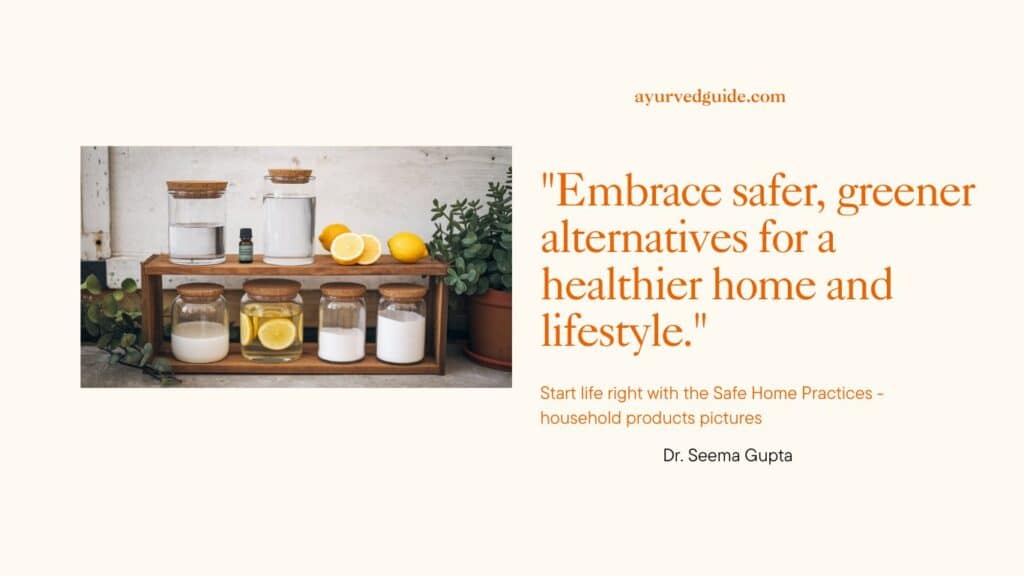
A. Options for natural and organic products
Using household products composed of natural, organic materials may help limit exposure to potentially dangerous substances. But “natural” doesn’t necessarily mean safe.
B. DIY solutions – Household Products
Homemade cleaning products and personal care items made with simple, non-toxic ingredients can be safe, effective, and inexpensive alternatives.
C. Changes in lifestyle to lessen exposure
Making simple changes, such as opting for glass instead of plastic containers and fragrances, opening the windows for better ventilation, proper bathroom maintenance, maintaining toilet safety, cleaning mold and mildew regularly, and combating plumbing issues, can help limit exposure to potentially harmful chemicals, also prevents slip and fall hazards.
IX. Conclusion – Household Products
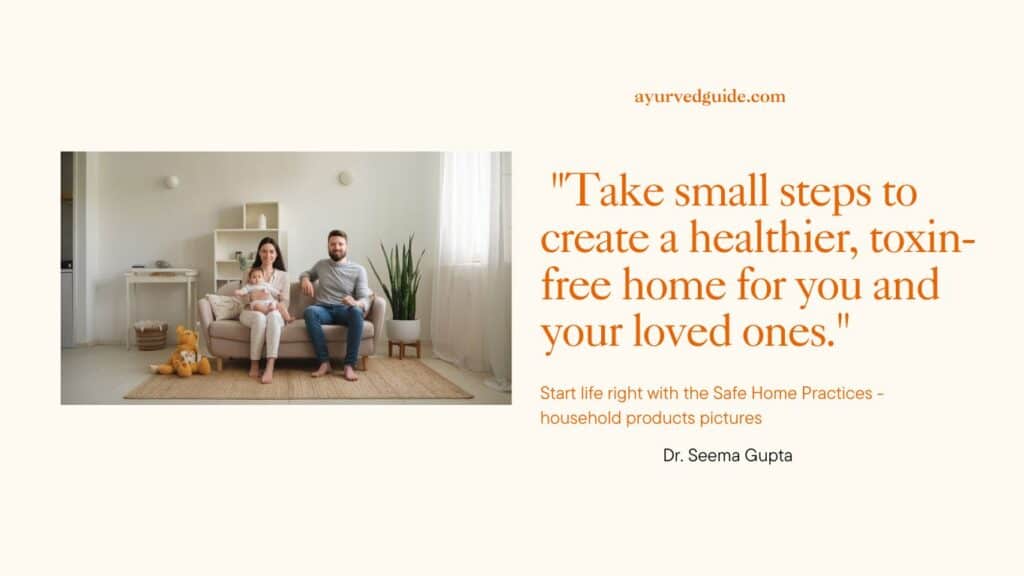
Regularly used, “everyday household products” can greatly affect our health, especially female exposure to specific chemicals.
We can each take specific steps to protect our health as well as our family members by being mindful of potential risks and making informed decisions.
Improving doesn’t have to be an all-out war. Begin gradually by switching out one product with a safer option each time you run out, or making small adjustments to your lifestyle to lower your exposure. Any move towards a healthier home is a good one.
X. FAQs
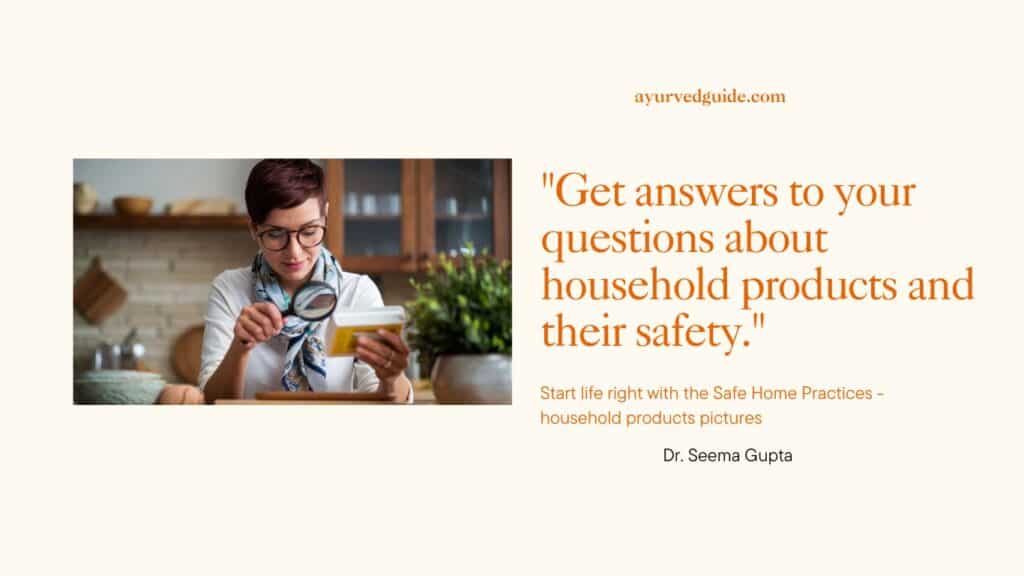
How do I know if I have potentially harmful products in my home?
Beginning to read product labels and research unknown ingredients. Seek products certified by credible third-party organizations that assess claims of safety and sustainability.
Are natural products necessarily safer?
Not necessarily. “Natural” doesn’t equate to safe or non-toxic. Some natural compounds can be dangerous, and the term is not rigorously defined. Always verify products and ingredients even if they say natural.
How can I reduce my exposure to toxic chemicals?
Opt for products with fewer ingredients, skip products with artificial fragrances, clean using natural methods (like vinegar and baking soda), ventilate your home, and store food in glass or stainless steel containers instead of plastic.
What do Household Products mean for pregnant women and developing fetuses?
Some chemicals can be particularly harmful to pregnant women and developing fetuses. Certain substances can cross the placenta, impacting fetal development. Pregnant women should avoid certain products and exposures.
Where can I get more information about product safety?
The Environmental Working Group (EWG), the Centers for Disease Control and Prevention (CDC), and the National Institutes of Health (NIH) are all reputable sources, for example. Such organizations inform consumers about product safety and possible health hazards related to various chemicals.
I hope, this article will be beneficial for you.
Dr. Seema Gupta, BAMS, MD (Naturopathy) is an Ex-House Physician in Gynecology and Obstetrics who is Advanced Certified in Diet and Nutrition. with over 27 years of experience in Women’s Health, Ayurveda, Naturopathy, and Diet, she has empowered 70,000+ patients to achieve natural healing. Her expertise in Gynecology and Obstetrics ensures personalized, science-backed advice.
